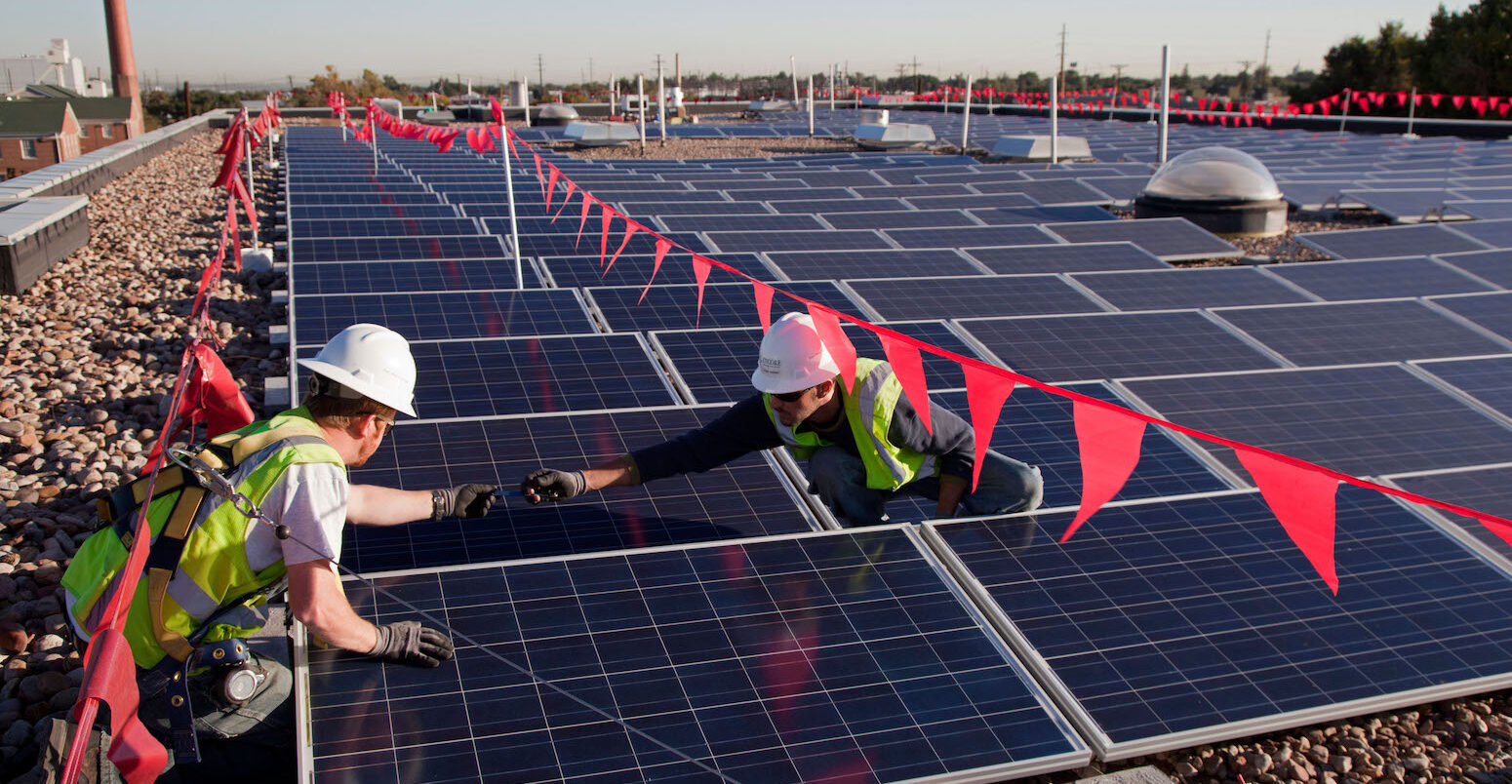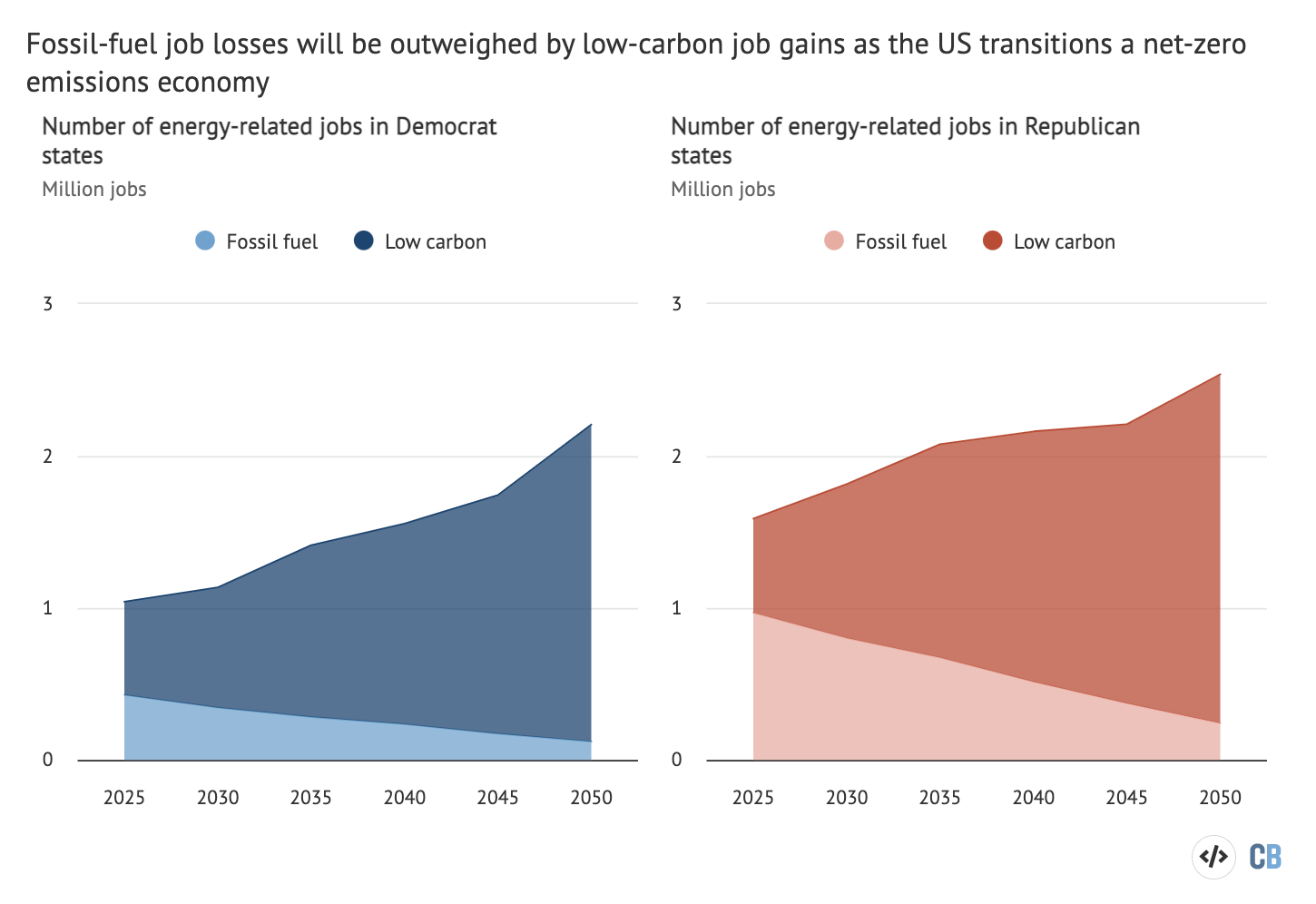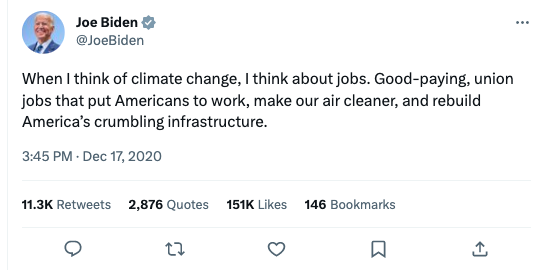
Jobs created by net-zero transition will ‘offset’ fossil-fuel job losses in Republican US states
Josh Gabbatiss
05.30.23Josh Gabbatiss
30.05.2023 | 4:55pmRepublican strongholds, such as Texas, Wyoming and Oklahoma, stand to gain hundreds of thousands of jobs in the clean-energy sector as the US moves to a net-zero economy, a new study concludes.
It finds that jobs in low-carbon industries would outweigh losses in most of the country’s fossil-fuel rich regions, as oil, coal and gas operations close down.
Total employment in the nationwide US energy sector could double or even triple by 2050 to meet the demand for wind turbines, solar panels and transmission lines, according to the modelling published in Energy Policy.
Republican leaders have rejected climate action for decades and have often weaponised the prospect of job losses in fossil-fuel communities against their Democrat rivals.
Yet the Biden administration has stressed the opportunities that the clean-energy transition will bring to US workers, stating that “creating jobs and tackling climate change go hand in hand”.
The research adds to mounting evidence that “red” (Republican-voting) states stand to benefit significantly from the shift to low-carbon energy. However, the authors note that many communities will still require help to ensure a “just transition” away from fossil fuels.
‘Jobs, jobs, jobs’
After years of political deadlock around climate action in the US, Democratic president Joe Biden came to power with a climate agenda focused on “jobs, jobs, jobs”. He emphasised the potential of a shift to net-zero emissions by 2050 to bring employment to millions.
The new study, led by Dr Erin Mayfield, an assistant professor of engineering at Dartmouth College, attempts to estimate the number of jobs that would be created in such a net-zero transition.
To do this, her team developed the Decarbonization Employment and Energy Systems (DEERS) model, which uses energy and labour market data to simulate different futures for the nation’s domestic energy supply chains.
They then applied the model to four scenarios from the Net Zero America study, a project that provides guidance on what the US pathway to net-zero could look like.
The scenarios rely on different levels of renewable energy and electrification to reach net-zero emissions by 2050. The modelling shows that all four pathways would result in a significant uptick in energy-related jobs, virtually all in low-carbon industries.
Employment in the energy sector increases from 2.8 million workers in 2021 to between 3.5 and 8.7 million by 2050, the study finds. This amounts to an increase from 1.5% of the US workforce to between 2% and 4.5%.
The black lines in the charts below show the net gain in energy-related jobs in each net-zero scenario. Growth in sectors such as the construction of wind turbines, solar panels and electricity transmission lines “offsets” the loss of jobs from the coal, oil and gas industries.
This is even the case for the E+RE- scenario, on the right, in which renewable energy deployment is significantly constrained.

The number of energy-related jobs roughly doubles in both the “high electrification” (E+) and “less-high electrification” (E-) scenarios, which focus on the extent to which transport and buildings are electrified by 2050. The largest growth is seen in the E+RE+ scenario, which features high electrification and a 100% renewable power system by 2050.
The researchers also modelled a “reference” case with no climate policies at all, finding only a small increase in energy-related jobs by 2050.
Red and blue
Many Republican leaders have remained staunchly opposed to renewables and climate policies for years, often citing the importance of fossil fuels for their states’ economies.
Of the top 10 energy-producing states, responsible for 71% of US energy production, seven backed the Republican candidate, Donald Trump, in the last presidential election. The majority of their energy production comes from oil, gas and coal.
Yet Republican-voting states also cover some of the sunniest and windiest parts of the US and, as a result, are the largest generators of wind and solar power.
They also stand to gain the most from the Biden administration’s landmark Inflation Reduction Act (IRA). Citing White House figures, Bloomberg has reported that Trump-supporting states in the last presidential election are set to obtain twice as much investment in renewable power projects through the IRA than states that backed Biden.
Ashna Aggarwal, a senior associate with the Rocky Mountain Institute who was not involved in the study, tells Carbon Brief that broadly these states are the best-placed to develop low-carbon energy industries:
“[There’s] the potential for clean resources, which red states have a tonne of, and then industrial activity, which red states also have a tonne of.”
The research concludes that in all net-zero scenarios, employment in fossil-fuel sectors will fall dramatically as the industries are phased out. However, the authors write:
“In most states, job losses in declining fossil fuel sectors are offset by an increasing number of energy jobs in low-carbon sectors.”
This is particularly evident in Republican-voting states, which have larger energy workforces. In the E+ scenario, these states would lose around 700,000 fossil-fuel jobs but gain 1.7m low-carbon energy jobs between 2025 and 2050.
This can be seen in the chart below, in which Carbon Brief has combined the total job numbers in “red” states that supported Trump in 2020. The bottom chart also shows the smaller losses and gains in “blue” Democrat states, which backed Biden.

The researchers cite the example of Texas, a Republican stronghold that has by far the largest fossil-fuel industry in the US.
By 2025 in the E+ scenario, around 480,000 of the state’s 660,000-strong energy workforce are employed in the fossil fuel sector, more than 72% of the total. Within 25 years, many of these jobs would be lost as the number of fossil-fuel employees falls to 123,000.
Yet the state would still see a big uptick in energy-sector employment by 2050. The modelling suggests Texas would have around 778,000 energy jobs in 2050, with around 84% employed in low-carbon industries.
Notably, the research finds that many fossil fuel jobs would have been lost even in the absence of new climate policy. It suggests there would be a drop of one-third by 2050, as coal and gas are driven out of the market by cheaper wind and solar.
Booms and busts
Overall, the net-zero transition results in a significant shift in the profile of the energy labour force. Coal mining declines “drastically”, whereas construction jobs increase significantly.
These changes mean that some communities, and some states, would feel the effects more than others. Aggarwal tells Carbon Brief:
“I think there is a risk in this type of analysis which presents a very macro scale…these are the jobs that will be gained and these are the jobs that will be lost. [That] can sometimes ignore what’s going on at a community level.”
The authors acknowledge this in the paper, noting that some fossil fuel producers, such as North Dakota, see net declines in energy-related employment. Others, such as coal-rich West Virginia, experience a short-term decline out to around 2030 before picking up again as 2050 approaches.
Such “boom-and-bust” cycles are described by the paper as a “recurring feature of energy markets”, but the authors also note that they can have “a large influence on national energy policy and discourse of energy transitions”.
Republican opposition to climate policies has often centred around local job losses. In 2016, Trump garnered support in coal-mining regions, including the swing state of Pennsylvania, at the expense of his Democrat rival for the presidency, Hillary Clinton, by promising a comeback for the fossil fuel. (Coal jobs fell by a quarter during Trump’s presidency.)
The study notes there are other important factors beyond the sheer number of jobs in different sectors.
For example, it concludes that the reference scenario in which no climate policies are enacted consistently results in “slightly higher” wages per energy-sector job. This is due to fossil-fuel jobs tending to pay slightly higher salaries than the largely construction-based jobs in renewable industries.
All of this matters, as Dr Irfan Khan, an assistant professor in electrical engineering at Texas A&M University who was not involved in the study, tells Carbon Brief:
“Ultimately, people’s response to the transition will be a crucial factor in determining the speed and success of the shift towards renewables.”
Even when fossil-fuel jobs are “replaced” with low-carbon ones, they may require different skill sets, pay different wages or be based in different locations. The authors emphasise the need for just transition measures, including funds to “compensate for lost wages, pensions and relocation”.
Khan also noted that while Biden has placed a “strong emphasis” on the energy transition, future employment patterns might shift considerably in a different policy environment. The authors acknowledge these limitations, noting that their modelling inherently provides an “idealised and simplified view of transitions” in the energy system.
Mayfield, E. et al. (2023) Labor pathways to achieve net-zero emissions in the United States by mid-century, Energy Policy, doi: 10.1016/j.enpol.2023.113516
-
Jobs created by net-zero transition will ‘offset’ fossil-fuel job losses in Republican US states


